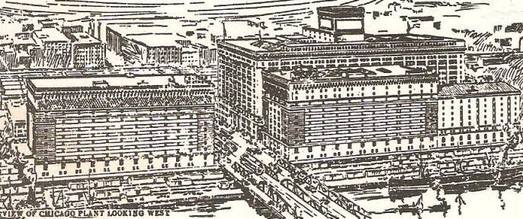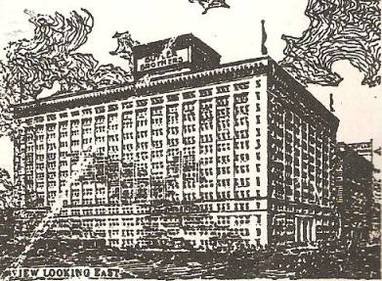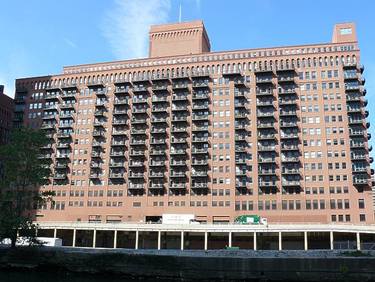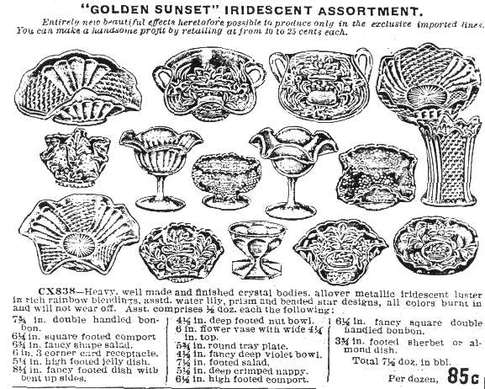How was Carnival Glass sold?
Like the sale of many products in the early 1900s, the chain from glassmaker to customer involved a chain of wholesalers and retailers. Thanks to the survival of a large number of sales and mail order catalogues from Butler Brothers, Lee Manufacturing, Mongomery Ward and others, we know a lot about the wholesale end of the business, and indeed the Butler Brothers catalogues have proved to be an invaluable way to attribute particular patterns to their maker. This is because Butler Brothers had the habit of advertising "assortments", in which all the pieces shown came from (or were despatched directly from) one factory - so if the maker of one of the pieces is known, the others can be attributed by association in the assortment.
Retail involved the usual sales in small individual stores, but there was also the practice of "giving" Carnival Glass items as a premium or reward - the early equivalent of "BOGOFF" deals! The idea was that if a customer bought X number of items, they received a piece of Carnival at a reduced price, or even "free".
Butler Brothers - "Our Drummer"
Retail involved the usual sales in small individual stores, but there was also the practice of "giving" Carnival Glass items as a premium or reward - the early equivalent of "BOGOFF" deals! The idea was that if a customer bought X number of items, they received a piece of Carnival at a reduced price, or even "free".
Butler Brothers - "Our Drummer"
 Above and below: images of Butler Brothers' Chicago warehouse around 1900
Above and below: images of Butler Brothers' Chicago warehouse around 1900
The Butler Brothers catalogues (known as "Our Drummer") were probably the main wholesale marketing outlet for Carnival Glass during the early 1900s. Charles, George and Edward Butler laid the foundations of Butler Brothers back in 1877 when they opened a little wholesale store at 50 Arch Street, Boston, Massachusetts.
They had vision and courage. At that time, the great American West was undeveloped. Methods of production and distribution were crude. Retail merchants bought most of their goods on spring and fall trips to market, purchasing the remainder from travelling salesmen.
Buying by mail order was relativley undeveloped. Thus the Butler Brothers system of establishing a major distribution house in each of the five “key” cities of the United States (New York, St. Louis, Chicago, Minneapolis and Dallas), was truly far-sighted.
The Butlers Chicago "plant" was opened in 1879. By 1910 (at the height of Carnival advertising) they employed around one thousand people. It's fascinating to ponder on what might have been housed within the walls of those buildings....... The massive warehouses that were home to vast stocks of the goods they sold were illustrated in line drawings on some of the catalogues, as shown.
They had vision and courage. At that time, the great American West was undeveloped. Methods of production and distribution were crude. Retail merchants bought most of their goods on spring and fall trips to market, purchasing the remainder from travelling salesmen.
Buying by mail order was relativley undeveloped. Thus the Butler Brothers system of establishing a major distribution house in each of the five “key” cities of the United States (New York, St. Louis, Chicago, Minneapolis and Dallas), was truly far-sighted.
The Butlers Chicago "plant" was opened in 1879. By 1910 (at the height of Carnival advertising) they employed around one thousand people. It's fascinating to ponder on what might have been housed within the walls of those buildings....... The massive warehouses that were home to vast stocks of the goods they sold were illustrated in line drawings on some of the catalogues, as shown.
|
The first Butler Brothers wholesale ad for Fenton's Carnival Glass,
September 1908. Courtesy of the late Frank M. Fenton The patterns in this splendid 1908 ad include Waterlily and Cattails, Beaded Stars, and Diamond Point Columns. This is the very first wholesale ad that we know of for Fenton's Carnival Glass. The colour was surely marigold - "Golden Sunset" iridescent! The following year, another Fenton ad included Stippled Rays, Honeycomb and Clover, Coin Dot and a compote in the seldom seen geometric pattern Finecut Flower. |
The warehouse still exists today: above is a photo taken in September, 2007, of the very same Butler Brothers' building in Chicago (shown here courtesy and copyright of Andrew Thistlewood). The splendid structure has been converted into apartments, as you can see.
Retail and Premiums
In our new features "Read All About it!" and "Sell it to me!" features, we show the many ways that Carnival Glass was promoted and sold and used as incentive premiums by retail outlets in the USA and in other countries, including England and Australia.
Retail and Premiums
In our new features "Read All About it!" and "Sell it to me!" features, we show the many ways that Carnival Glass was promoted and sold and used as incentive premiums by retail outlets in the USA and in other countries, including England and Australia.
* NOTE: our use on this website of extracts from Butler Brothers catalogues are courtesy of, and with sincere thanks to the dedication of (the late) Dean and Diane Fry and the Southern California and San Diego Carnival Glass Club in sourcing and preserving these catalogues. They are an amazing resource for collectors and researchers.


